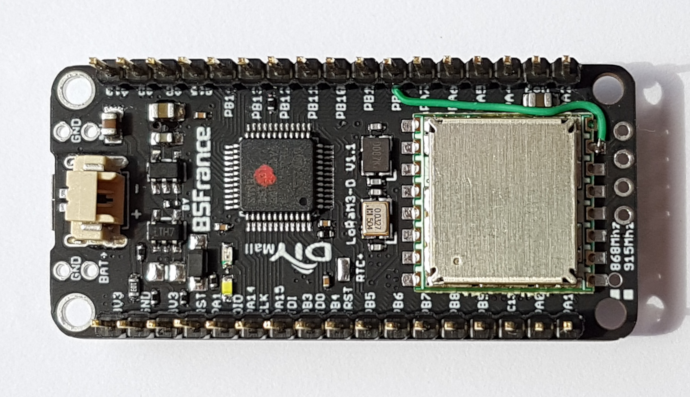Can’t edit above post anymore so I do it here:
Forget the remark ‘aka stm32duino’ because it is incorrect and confusing.
Arduino cores for STM32 (and naming confusion)
Forum
There is a special forum for Arduino and STM32: Arduino for STM32
“Everything relating to using STM32 boards with the Arduino IDE”.
This forum also hosts dedicated sections for specific Arduino cores.
See: http://www.stm32duino.com/
Arduino and cores
Arduino is a popular open source hardware and software ecosystem for developing microcontroller applications. It was originally developed for educational purposes.
The Arduino ecosystem consists of a runtime with standard API’s for running applications, an integrated development environment called the Arduino IDE that includes compilers (C/C++), tools for uploading and libraries.
The source code of an Arduino application is called a sketch. The sketch, software libraries and the Arduino runtime are all compiled into a single binary file that is then uploaded to the microcontroller board.
The Arduino core in principle is the Arduino framework runtime code that is required to run an Arduino application. Originally Arduino only supported 8-bit AVR microcontrollers but when it was ported to other microcontroller platforms like ARM Cortex M (SAMD21 and STM32), ESP8266 and ESP32, that also required different compilers and tools. Therefore the term Arduino core now not only refers to the runtime, but also to the compilers, tools, libraries, board definitions etc., that are required for a specific microcontroller (family).
Cores can be provided by microcontroller manufacturers, by board manufacturers, by individuals or by a community. Cores are installed via the Arduino IDE Boards Manager (when supported) or can be installed from files from the core’s Github repository.
Arduino cores for STM32
There are several Arduino cores available for the STM32 family of microcontrollers. The most relevant ones are described below. Compatibility and supported features of these cores can be different so they are not fully compatible. Ech core supports a limited set of boards. Some boards (e.g. bluepill) are supported by multiple cores while others (e.g. LoRaM3-D) are only supported by a single core.
Arduino STM32
Roger Clark’s popular Arduino STM32 core is a derivative of libmaple (GitHub - leaflabs/libmaple: [INACTIVE] C and C++ library for STM32 ARM Cortex-M3 development boards.) which was first developed by LeafLabs for their Maple and Maple mini boards. LibMaple and hence Arduino STM32 only supports the STM32F103 series of microcontrollers. This core directly accesses the hardware registers and is therefore difficult to port to other microcontrollers from the STM32 family. This is one of the older and more mature cores.
This core can be installed either using the files from github or via a Boards Manager package.
See: https://github.com/rogerclarkmelbourne/Arduino_STM32
In the Arduino Boards Manager this core is listed as “STM32F1xx/GD32F1xx boards by stm32duino”.
In the Tools/Board dropdown its supported boards are listed under “STM32 Boards (STM32duino.com)”.
Bootloader:
Roger Clark also developed a special bootloader known as the STM32duino bootloader. It is available for different STM32 F103 based boards and supports automatic uploading from sketches via USB. GitHub - rogerclarkmelbourne/STM32duino-bootloader: Bootloader for STM32F103 boards, for use with the Arduino_STM32 repo and the Arduino IDE
Arduino Core STM32
STM have produced an Arduino Core, which now supports multiple microcontrollers from the STM32 family of products. The core is based on the STM HAL, which makes it easier to support and port to other members of the STM32 family. This core is relatively new but it is at least supported by ST-Microelectronics, the manufacturer of the STM32. For the STM32F103 series the USB DFU upload method is not supported.
This core can be installed either using the files from github or via a Boards Manager package.
See: https://github.com/stmduino/Arduino_Core_STM32
The term stm32duino is already used by Roger’s ‘Arduino STM32’ core and bootloader so using stm32duino as the Github user name and location for the repository of the completely different ‘Arduino Core STM32’ core is unsmart and utterly confusing (unless the other STM32 cores would also be hosted under the stm32duino Github account, but that probably isn’t going to happen).
In the Arduino Boards Manager this core is listed as “STM32 Cores by ST-Microelectronics”.
In the Tools/Board dropdown its supported boards are listed under “STM32 Boards (selected from submenu)”.
STM32GENERIC
‘A generic implementation of Arduino for STM32 boards’. This core (developed by Daniel Fekete) also uses the STM HAL, but the structure and architecture of the core differs from STM’s implementation.
There is no Boards Manager package for this core so it has to be manually installed using the files from github. See: https://github.com/danieleff/STM32GENERIC and https://danieleff.github.io/STM32GENERIC/
In the Tools/Board dropdown its supported boards are listed under “STM32GENERIC for STM32 boards”.
BSFrance-stm32
This core from BSFrance is specific for their LoRaM3-D boards. This core is also based on the STM HAL and it appears to be based on a fork of STM32GENERIC.
There is no Boards Manager package for this core (yet) so it has to be manually installed using the files from github. See: https://github.com/BSFrance/BSFrance-stm32
In the Tools/Board dropdown its supported boards (currently) are listed under “STM32(HALMX & LL)”.
PlatformIO support
I haven’t had a good look at Arduino + STM32 support in PlatformIO yet, but there is support for it.
PlatformIO shows ‘ST STM32’ as a supported platform with ‘framework-arduinoststm32’ as an available package, but it is not clear which of the above Arduino cores for STM32 are supported.
At least Roger’s ‘Arduino STM32’ core appears supported because I have an LMIC LoRa example working in PlatformIO with the ‘bluepill’ board using the USB DFU upload method. (The BSFrance-stm32 core is not currently supported in PlatformIO.)

